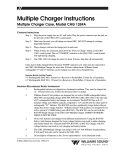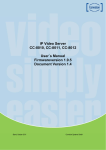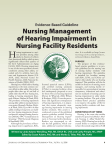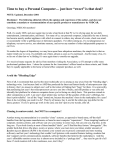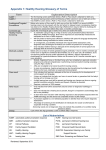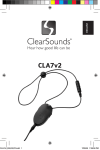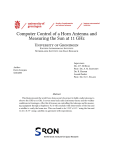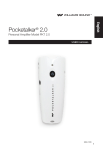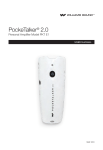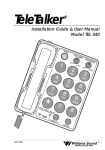Download Sections of pre-reading
Transcript
CARE FOR ELDERS UBC Department of Family Practice Communication: Hearing Loss in Elders Pre-reading December 2008 Acknowledgments: Communication: Hearing Loss in Elders (2008) Funding for the Care for • Lorienne Jenstad, PhD, Aud(C) Elders modules was made • Barbara Purves, PhD, SLP(C) possible by the Special • Marcia Carr, RN, BN, MS, GNS(C), NCA Population Funds, through • Margaret McPhee, MA, MSc., AIMSW the UBC Faculty of Medicine. • Sara Alberni, BA, Graduate student For information on other Additional contributions from: modules please contact: • Andrea Cosentino, MA Division of Community • Adrian Lister, BEng, Graduate student Geriatrics • Daniela Chifor, MD Dr. Martha Donnelly Department of Family Practice c/o GPOT-CP5D 855 West 12th Ave. Vancouver, B.C. V5Z 1M9 [email protected] Contents WELCOME........................................................................................ 1 Goals and learning objectives .......................................................... 2 Introduction........................................................................................ 3 The Problem of Hearing Loss ........................................................... 3 What is Hearing Loss? ..................................................................... 5 Suggestions for Simulating Hearing Loss ......................................... 8 Hearing Loss in the Context of Other Age-Related Changes ........... 8 Your Role as a Health-Care Provider .............................................. 10 How do you know if your patient has a hearing loss? ....................... 10 The “How-to’s” of the 3 recommended screening methods .............. 11 Referring the Patient......................................................................... 15 Hearing Aids ..................................................................................... 15 Strategies for Effective Communication............................................ 23 Other Hearing Assistive Technology ................................................ 25 An Emergency Tool Kit for Successful Communication with 26 Hearing-Impaired Adults .............................................................. 26 References ....................................................................................... 28 Additional Information: Case Presentation (page one of case) Evaluation Form Welcome to the Care for Elders Modules! The Care for Elders modules have been written for and by interdisciplinary teams. These modules are unique in that they are interactive and participatory. The goal is for you to learn about elders and also about you – exploring your role and attitudes; other disciplines; your team and how to work as part of a team caring for elders. The Care for Elders learning experience is comprised of two parts: 1) Pre-reading - this is a general comprehensive overview of one topic 2) A 2 to 3 hour small group session with case study discussion. • To get the most out of this module it is strongly recommended that you read the prereading package. Information in the pre-reading is reviewed during the small group discussions. • Small groups will consist of 6-10 participants from various disciplines, and a facilitator. • The facilitators will not ‘teach’; rather your small group will discuss one fictional case using the information you possess, and the information you acquired from the prereading. The learning is accomplished if your team fully discusses the questions asked in the case study. • The facilitator’s role is to guide discussion and ensure that all learning points are covered during the session. Your facilitator is NOT expected to provide information! We hope that this experience will be a rewarding one for you! Communication: Hearing Loss in Elders – Pre-reading July 20, 2011 1 Communication: Hearing Loss in Elders Goals and Learning Objectives At the end of the Communication module, you will be able to: 1. identify general age-related changes in oral articulation and cognitive processing that affect communication with older adults, 2. identify specific age-related sensory changes in vision and hearing that affect communication with older adults, 3. read an audiogram and interpret the results of the hearing test shown, with specific implications for listening to conversational speech, 4. describe techniques and approaches that facilitate effective communication with older adults, specifically: a. identifying and modifying environmental barriers to communication, including background noise and poor lighting b. maintaining respectful communication that helps accommodate for the older adult’s sensory changes while not being condescending c. accommodating for language barriers due to differences in primary language spoken or language loss due to aphasia d. using alternative modalities, including hand signals, gestures, and written materials to support communication, 5. articulate the magnitude of the problem of hearing loss, including the prevalence of the loss, the safety concerns when warning signals are not heard, and the contribution of hearing loss to misdiagnoses of depression and dementia, 6. differentiate between effective and ineffective screening tools for hearing loss and know how to administer some of the common, effective screening tools, 7. determine when a patient should be referred to an audiologist or physician on the basis of either screening results or symptoms, 8. identify hearing aid styles and components, 9. troubleshoot hearing aids to identify and solve common problems related to batteries, feedback, cerumen build-up or volume control, and to know when to encourage the patient to return to the audiologist for problems that need further repair, and 10. appropriately select and use non-prescriptive hearing-related technology to improve the quality and accuracy of interactions with patients with hearing loss. Communication: Hearing Loss in Elders – Pre-reading July 20, 2011 2 INTRODUCTION Successful communication between health care professionals and their patients is vital to good health care and optimal outcomes. It is important to keep in mind that communication, by definition, is always interactive; this means that even if only one person has a problem that negatively impacts communication, all participants share that negative impact. This can include, for example, miscommunication, as well as the increased stress and fatigue (and time!) associated with trying to communicate in the face of challenges. There are many changes associated with aging that can negatively impact communication. Fortunately, there are also many ways to mitigate the impact of these changes. The goal of this module is to identify strategies and resources that you can use to promote successful communication despite impairments, focusing in particular on the most common communication problem of older adults – hearing loss. Hearing loss is the third most prevalent chronic disabling condition among older adults. The only conditions that are MORE prevalent are heart disease and arthritis. Chances are, many of the older patients you work with on a daily basis have hearing loss and you (or they) may not know it. There are several reasons why it is important for you to know both how to identify a potential hearing loss and also what to do about it. First, for you to do the best possible assessment and intervention, you need to have good communication with your client, so you will want to know how to achieve this despite your client’s hearing loss. Second, you may be the first health care professional to identify a potential problem, so you need to know what resources are available. Third, the symptoms of hearing loss can be very similar to other conditions that affect older adults, such as dementia and depression. It can be difficult to differentiate between hearing loss and the other conditions, but it is important to do so. For example, the apparent symptoms of cognitive decline may in fact be caused by hearing loss. It is important to know which of these conditions is present so that you can develop appropriate strategies to address the underlying problems. Finally, it is important to keep in mind that communication is a complex human activity with many interacting components. While hearing loss may seem like a relatively straightforward problem, it is complicated by many other factors including those within the person (e.g., vision, cognition, emotional state), in their communication partners (e.g., that person’s voice quality, style of speech, etc.) and in the environment (e.g., background noise). In order to understand fully how to identify hearing loss and how to optimize communication when hearing loss is present, we need to understand these interactions. THE PROBLEM OF HEARING LOSS Hearing loss is the inability to hear some sounds at the low levels at which people with normal hearing are able to detect these sounds. Hearing loss doesn’t refer just to total loss of the ability to hear, but includes a whole range, from needing only a few sounds Communication: Hearing Loss in Elders – Pre-reading July 20, 2011 3 to be a bit louder, up to total loss of hearing. As we’ll find through this module, there are many degrees, or levels, of hearing loss, and even the mildest of losses can have devastating consequences. Prevalence Among adults older than 45 years of age, the prevalence of hearing loss is 46%, with higher rates of hearing loss among males than females. The prevalence increases with increasing age: 89.5% of adults over the age of 80 years have hearing loss1, 2. The reported prevalence of hearing loss is much lower when the numbers are based on self-reports of hearing loss2. This means that many people are simply unaware of their hearing loss. Safety Issues Untreated hearing loss can have implications for an older person’s safety in the home. Safety can be compromised by either not hearing warning signals or other auditory alerts, such as someone knocking at the door. Anecdotally, it seems that many older adults with hearing loss cope with not being able to hear a knock at the door, or a doorbell, by leaving their door unlocked, with a sign posted for the expected caller to come in. The prevalence of such behaviour is not known, but many health care workers working with older adults report noticing such signs. Leaving the door unlocked, with a sign announcing that the door is unlocked because the resident has hearing loss, leaves the resident vulnerable to attack, home invasion, and other safety concerns. Most fire deaths occur during the night, despite the fact that domestic fires are more likely to occur in the daytime, in part because audible fire alarms are not effective to wake people from sleep (even people with normal hearing). People with hearing loss are even less effectively woken by fire alarms than people with normal hearing, and thus are at greater risk for serious injury or death from a house fire3-5. Association with Depression Because hearing loss makes verbal communication more difficult, hearing loss can lead to social isolation, voluntary withdrawal from social events, reduced interactions with other people, and difficulties in close relationships (e.g., marital problems due to miscommunication)6, 7. There are 2 possible effects here: 1. The symptoms of hearing loss may be mistaken for depression. It is important to rule out hearing loss before diagnosing depression. 2. The effects of hearing loss (social isolation, etc), may cause depression. If this is the case, it is important to have the hearing loss managed as part of the depression management plan. Communication: Hearing Loss in Elders – Pre-reading July 20, 2011 4 Association with Cognitive Symptoms The difficulties of not hearing properly in conversation can look similar to cognitive decline8. Imagine not properly hearing in a conversation; when someone asks you a question that you don’t quite hear you may pause while you try to figure out what was said. Then, even if you’re not sure of the question, you may try answering. If your answer is inappropriate (e.g., the question was “How are you today?” and you answer “Yes it is, isn’t it?”), it may seem as if you are confused. Many such disjointed conversations may lead to a false suspicion of dementia. On formal tests (or screening tests) for dementia, people may fail the test because they simply aren’t hearing the spoken items properly. If steps are taken to ensure that the patient can hear properly; for example, by ensuring that the room is quiet and well-lit, that the examiner’s voice is clear, and that hand-held amplifiers are used if necessary, the results of the cognitive test will be much more accurate. In some cases, when it is ensured that the patient can hear the test items, the appearance of dementia symptoms is minimized or disappears altogether. The number of older people affected by hearing loss, and the implications of hearing loss for safety, depression, and diagnoses of dementia, make hearing loss a significant health issue. All health care providers who work with older adults should be aware of the symptoms and management of hearing loss for the well-being of their patients. WHAT IS HEARING LOSS? Hearing loss presents differently in each person. There are different degrees of hearing loss. One of your patients may be quite obviously hearing impaired, because he doesn’t hear anything unless you talk loudly close to his ear. Another patient may hear you perfectly well if you talk to her in your normal voice during face-to-face conversations, but seem “out of it” if there is any distracting noise around. It is possible that this second patient also has hearing loss, but of a milder degree; so she only has difficulties when it’s noisy, or when the speech she needs to hear is very soft. Another variation among hearing losses is the pitch at which the loss occurs. Some people have equal hearing loss at all pitches; so a soft sound at any pitch will be hard for them to hear. It is more common, though, for people to have different amounts of hearing loss at different pitches. In older adults, the common pattern is to be able to hear low-pitched (or bass) sounds, but have hearing loss for high-pitched (or treble) sounds9. This means that you may observe your patient responding to a very quiet bass sound, but still showing signs of confusion or disorientation. Just because the patient seems to hear normally for some sounds, hearing loss cannot be ruled out. There are 2 main types of hearing loss: conductive and sensorineural. A conductive loss can occur in the ear canal, at the eardrum, or in the middle ear. It refers to any disorder that interferes with the conduction of the signal before it reaches Communication: Hearing Loss in Elders – Pre-reading July 20, 2011 5 the inner ear. Many conductive hearing losses are treatable or reversible with medical intervention, or the loss resolves on its own over time. Some selected causes of conductive hearing losses are: CAUSE TREATMENT OPTIONS Wax (cerumen) build-up in ear Wax removal. canal WHO? Doctors & nurses SOME audiologists are certified to perform wax removal Eardrum perforation Surgery or self-healing Doctor / ENT Middle ear infection Antibiotics or tubes Doctor/ ENT Otosclerosis Surgery Hearing Aid Patient should first be assessed by an ENT physician to determine whether surgery is an option. After medical clearance, an audiologist can assess patient for a hearing aid fitting. Sensorineural loss: This is what people often refer to as “nerve deafness,” but that is not an accurate name for it. Sensorineural loss happens in the inner ear, which is comprised of a snail-shaped structure called the cochlea, and the auditory nerve, which connects the inner ear to the brain’s higher centres. Sensorineural hearing loss is permanent, and in most cases, hearing aids are the treatment of choice. Some common causes of sensorineural hearing loss: • Noise exposure • Age-related hearing loss • Genetics • Illnesses • Meniere’s disease Communication: Hearing Loss in Elders – Pre-reading July 20, 2011 6 Note that many people have BOTH conductive and sensorineural components to their hearing loss. This is referred to as “mixed” hearing loss. The main component of hearing assessment is the audiogram. The audiogram is a chart of the patient’s hearing. An example is shown in the figure. An audiogram is a graph of the quietest sounds a person can hear at different frequencies. Frequency is defined as the cycles per second of a sound wave and is measured in Hertz (Hz). More simply, low frequency sounds are perceived as low pitched, and high frequency sounds are perceived as high pitched. On the audiogram, the low frequency sounds are on the left and the high frequency sounds are on the right. The loudness or intensity of the sound is measured in a scale called decibels (dB). Low decibels are represented at the top of the audiogram and high decibels at the bottom. This is not a percentage but a measure of the intensity of the sound. On the audiogram, the softest sounds that the patient can hear at the different frequencies are marked by circles for the right ear and x symbols for the left ear. Since high decibels (loud sounds) are represented at the bottom of the graph, marks closer to the bottom of the page represent worse hearing. Hearing loss can vary in degree from mild to profound. Audiologists describe the degree of hearing loss using the following categories. • 10 to 25 dB HL normal range • 26 to 40 dB HL mild hearing loss • 41 to 55 dB HL moderate hearing loss • 56 to 70 dB HL moderately severe hearing loss • 71 to 90 dB HL severe hearing loss • 91 + profound hearing loss For most patients, the hearing loss will be worse at some frequencies than others. For example, most age related hearing loss is worse in the high frequencies than in the low frequencies. This is called a sloping configuration. Audiologists describe the hearing Communication: Hearing Loss in Elders – Pre-reading July 20, 2011 7 loss in terms of its configuration as well as degree and type. For example, the hearing loss of the patient whose graph is shown could be described as a mild sloping sensorineural hearing loss above 1000 Hz in the right ear and a mild to moderately severe sloping sensorineural hearing loss above 1000 Hz in the left ear. SUGGESTIONS FOR SIMULATING HEARING LOSS It is difficult to understand hearing loss just from reading a description. There are several ways for you to understand better what hearing loss actually sounds like, and what it’s like to live with. The following websites offer simulations of hearing loss. Enter one of these addresses into your browser (or do an internet search for “hearing loss simulation”) and follow the instructions given. http://www.phonak.com/consumer/hearing/hearinglossdemo.htm http://www.betterhearing.org/sound/index.cfm You can also try wearing earplugs for a day, to see what it’s like to function in everyday life with a hearing loss. Foam earplugs are readily available for a very low cost at drugstores. When you insert the plugs, it is important to make sure you insert them properly to get the full effect. (Follow the directions on the package). Try wearing earplugs in both ears for a full day; see what it’s like to have conversations, conduct business transactions, and get oriented to your environment. Communicating with someone with untreated hearing loss can be frustrating, particularly when it is important to quickly exchange important health-related information. Some strategies that we naturally try, such as shouting, aren’t very helpful in making communication any smoother. A more effective strategy is to talk more slowly and clearly. Overcompensating in this way may come across as condescending, though. HEARING LOSS IN THE CONTEXT OF OTHER AGE-RELATED CHANGES Because of all the other possible changes that may co-occur with aging10, it is important to be aware of the other changes that can affect communication, to know how best to help compensate for the effects of hearing loss. For example, if it is difficult for the client to hear, it may be helpful to try other ways of communicating, such as writing down important information. It is important to be aware of age-related changes in vision to be able to effectively use this strategy11. A note of caution: As you are likely aware from your work with older adult patients, there is a lot of variability from one person to the next12. Some of these age-related changes described in the following table may begin in some people as early as age 50, and develop gradually throughout the rest of their lives. Other people may have a later onset, or the change may be quicker. Still other people show no deficits in these areas even well into their 90s. Communication: Hearing Loss in Elders – Pre-reading July 20, 2011 8 SENSE/ABILITY AGE-RELATED CHANGE Hearing Thickening of the tympanic membrane, build up of ear wax, and damage in the inner ear lead to 1. presbycusis (mainly high-frequency loss) which will affect speech understanding13 2. possibly increased auditory reaction time 3. particular difficulties when listening in noise Sight/Vision Loss of elasticity of eyelids, lens thickening and becoming more opaque (cataracts), decreased pupil size and increased propensity for macular degeneration (wet is usually more treatable than dry type) lead to 1. eyelids drooping and turning inward which may affect range of vision from obstruction 2. colour distortion especially in the blues, greens, browns 3. decreased tolerance to glare 4. slower adjustment and adaptation to dark and light 5. peripheral vision narrowing 6. changes in near-sightedness Oral Articulation Gums shrinking and weight loss can lead to 1. poor fitting dentures 2. no dentition at all 3. dental caries that contribute to sore mouth Together, these changes can affect the ability to form words well, and may make it more difficult for you to understand your patient. Language Language abilities are generally well-preserved in older adults. Cognitive Processing Older adults’ thinking processes tend to become slower. HOWEVER, this does not mean that they do not or cannot understand what is being asked or said to them. This can lead to: 1. misinterpretation of the communication because they are still processing the information but the interviewer is wanting an answer quickly 2. assumption by the interviewer that the patient is unable to comprehend The above changes are all associated with normal aging. In addition to these, however, older adults are also at increased risk for developing other conditions that affect communication including, for example, language problems associated with dementia or aphasia resulting from stroke. Other disorders that are more common in the elderly Communication: Hearing Loss in Elders – Pre-reading July 20, 2011 9 include Parkinson’s, which can result in dysarthria, (meaning imprecise speech due to impaired articulation abilities and/or changes in voice quality – language in this condition is not impaired). For many people with Parkinson’s disease, speech is characterized by quiet voice volume, imprecise articulation with sounds blurring together, and a monotone with little variability. While this kind of speech can be difficult for a listener with normal hearing to understand, it is particularly challenging for someone with hearing impairment. This is important to keep in mind, because elderly couples may have combinations of impairments that make communication between them especially difficult14, 15. YOUR ROLE AS A HEALTH-CARE PROVIDER Many people who have hearing loss don’t realize it, are in denial, or don’t wish to pursue treatment. It is important that treatment begins early to a) maintain quality of life; b) maintain functioning of the auditory system; c) introduce and support use of and listening with hearing aids early, when it is easier to do so (i.e., before hearing loss becomes a greater problem because of multiple co-occurring deficits). Knowledgeable health-care providers can help to screen for hearing loss, recognize the signs and symptoms of hearing loss, and encourage their patients to seek treatment. It is important to screen for hearing loss for two reasons: first, if your patient has hearing loss, you may need to make accommodations during further assessment and communication to ensure that they can hear; second, it will be important to refer the patient for further hearing testing. The people who are qualified to assess hearing loss and provide appropriate intervention are Audiologists, professionals who have graduatelevel training in this area. HOW DO YOU KNOW IF YOUR PATIENTS HAVE A HEARING LOSS? It may be evident, if they already have or are using hearing aids. Sometimes determining whether someone has a hearing loss is as simple as asking whether he thinks he has a loss. If the answer is “yes,” it is highly likely that he has hearing loss. However, if the answer is “no,” it is still possible that a significant amount of hearing loss is present, because the patient may not be aware of the loss, or is in denial. Therefore, it is important to know how to quickly and accurately check whether hearing loss may be present. Because people do have different degrees and configurations of hearing loss, it is not possible to tell from a conversation alone, whether someone has hearing loss. Standardized measures exist to determine quickly whether or not someone may have a hearing loss. General principles of screening tools The three commonly-accepted screening methods are the Audioscope, the HHIE-S, and the Whispered Voice Test. These tests all attempt to assess the likelihood that an individual has a significant hearing loss which impairs their day to day functioning. Each of these tests, however, has its limitations: the Audioscope can assess only physical limitations of the auditory system, the HHIE-S assesses only an individual’s self Communication: Hearing Loss in Elders – Pre-reading July 20, 2011 10 perceived communication function, and the Whispered Voice Test is non-standardized, leading to poorer inter- and intra-tester reliability. Research into the specificity and sensitivity of these tests, however, suggests that they are all viable screening tests for hearing impairment1, 16. THE “HOW-TO’S” OF THE 3 RECOMMENDED SCREENING METHODS Audioscope What is it? A combined otoscope and hearing screener. The hearing screener allows you to present tones across the range of frequencies (pitches) most relevant for speech understanding (i.e., 500, 1000, 2000, and 4000 Hz). How to get it? Retail price ~$900. Manufactured by Welch Allyn; so you can purchase it from any distributor of Welch Allyn products. If you don’t already have a distributor, you can call Welch Allyn's Canadian Headquarters at 1-800-561-8796 to find the distributor closest to you. In Greater Vancouver, the following companies are distributors: Stevens Co., Delta, BC 604-634-3088 Source Medical, Burnaby, BC 604-421-8588 How to administer the screening? The Audioscope can screen at 20, 25 or 40 dB HL. The recommended screening level for adults above 65 years is 40 dB. Adults younger than 65 should be screened at 25 dB. Prior to the screening tones, a pre-tone is presented at 1000 Hz, 20 dB higher than the screening level. 1. 2. 3. 4. 5. 6. 7. 8. 9. Ensure that the testing room is quiet and free from distraction. Select either a small, medium or large speculum tip and attach it to the Audioscope. Select the 40 dB HL screening level on the Audioscope. Instruct the patient: “You will hear a loud beep followed by some fainter ones. You should say “yes” (or raise your hand) when you hear the beep.” Pull the outer ear back and up, insert the Audioscope speculum tip into the ear canal, and press “start”. Record the patient’s responses on the screening form. Test the other ear the same way. If the patient does not respond to one or more frequencies, he or she should be reinstructed and screened again. On the second screening, if the patient still fails to respond to 1000 or 2000 Hz, the patient should be referred to an audiologist and/or otolaryngologist for a full audiologic evaluation. Communication: Hearing Loss in Elders – Pre-reading July 20, 2011 11 Further details on how to use the Audioscope and administer a hearing screening can be found in the Audioscope III User Manual. Characteristics of the test: If these instructions are followed, the screening takes no longer than 90 seconds and is highly sensitive to detecting hearing loss.1, 16, Hearing Handicap Inventory for the Elderly (short form) What is it? The Hearing Handicap Inventory for the Elderly (screening version) is a short questionnaire with 10 questions, designed to screen for a hearing related handicap. The questions target the patients’ own perception of their hearing impairment and how it affects their lives. How to get it? The form is printed here in its entirety (with permission of its developer, Barbara Weinstein) and may be reproduced for clinical use. How to administer the screening? The form should be printed in a large font (minimum 14 point) to allow patients with vision problems to read it easily. For patients with literacy or vision problems which preclude their answering a written questionnaire, the questions can be presented verbally. The questions are answered yes (4 points), sometimes (2 points) or no (0 point). A final tally of points is then calculated. If the points total is higher than 8, the patient should be referred to an audiologist. Characteristics of the test: If a patient scores higher than 8 on the HHIE-S, there is a high likelihood that the individual has a significant hearing loss. 1, 16 The test has high test-retest reliability. Communication: Hearing Loss in Elders – Pre-reading July 20, 2011 12 INSTRUCTIONS: The purpose of this scale is to identify the problems your hearing loss may be causing you. Please select YES, SOMETIMES, or NO for each question. Do not skip a question if you avoid a situation because of your hearing problem. To obtain a total score, add up the YES (4 points), SOMETIMES (2 points), and NO (0) responses. If the score is greater than 8, we recommend a referral to an audiologist for a full hearing evaluation. YES SOMETIMES NO (0) (4) (2) Does a hearing problem cause you to feel embarrassed when you meet new people? Does a hearing problem cause you to feel frustrated when talking to members of your family? Do you have difficulty when someone speaks in a whisper? Do you feel handicapped by a hearing problem? Does a hearing problem cause you difficulty when visiting friends, relatives, or neighbors? Does a hearing problem cause you to attend religious services less often than you would like? Does a hearing problem cause you to have arguments with family members? Does a hearing problem cause you difficulty when listening to TV or radio? Do you feel that any difficulty with your hearing limits or hampers your personal or social life? Does a hearing problem cause you difficulty when in a restaurant with relatives or friends? TOTAL SCORE: HHIE-S _____________ than 8. Refer to audiologist if score is greater Communication: Hearing Loss in Elders – Pre-reading July 20, 2011 13 The Whispered Voice Test What is it? The Whispered Voice Test is a simple, quick, inexpensive way to screen for hearing loss. The patient is asked to repeat a string of whispered letters and numbers. How to get it? No equipment or materials are needed to administer this test. How to administer the screening? It is very important that you follow these directions exactly; otherwise the test is meaningless. 1. Instruct the patient: “You will hear me say some letters and numbers to you. Repeat back everything you hear.” 2. Stand 2 feet (approximately one arm’s length) away from the patient’s side and slightly behind. You should ensure that you are out of the patient’s field of vision. 3. Take a full breath, exhale, and whisper a string of 3 random numbers and letters; for example, “5 Y 8”. tragus 4. WHILE you are whispering the words, simultaneously use a finger to block the opposite ear canal by holding the tragus closed, making a gentle rubbing motion. The rubbing action will create noise in the opposite ear, preventing it from contributing to the hearing of the test ear. 5. Normal hearing patients should be able to repeat all 3 letters and numbers correctly. If the patient responds incorrectly, the test should be repeated using a new string of letters and numbers. If at least 3 out of 6 letters and numbers are repeated correctly, the screening is considered a pass. 6. Test the other ear in the same manner, using a new string of letter and numbers. 7. If the patient does not seem to understand the directions, a trial run using a loud voice may be used to demonstrate the procedure to the patient. Characteristics of the test: The patient must correctly repeat back 50% of the test items to pass. However, variability is high because stimulus intensity is not standardized.1, 16 You can reduce variability in the test by staying at the specified distance behind the patient, and taking a full breath and exhaling. This helps ensure a constant volume of your voice. Other screening tools that are used but are NOT recommended for clinical screening are17 • • • Finger-rub Tuning forks Watch tick Communication: Hearing Loss in Elders – Pre-reading July 20, 2011 14 These tests are not standardized, have poor test-retest reliability, and are not good for classifying someone as having hearing loss or not. To do one of these tests would be a waste of your clinical time. Screening tests for hearing loss: Recommended screening tests NOT Recommended screening tests Audioscope Finger rub Hearing Handicap Inventory for the Elderly Tuning forks Whispered Voice Test Watch tick REFERRING THE PATIENT If your patient needs to be referred as a result of the hearing screening, or he/she complains of hearing problems, it is possible to refer to either an audiologist or a physician. Most complaints related to having difficulties with hearing are best addressed by an audiologist. However, the following list gives circumstances when a patient should be referred to a physician. • • • • • • • Rapid onset or fluctuating hearing loss Active or visible drainage from the ear canal Ongoing ear pain Unilateral or pulsatile tinnitus Acute or chronic dizziness Foreign object in the ear canal Visible or unexplained abnormality of the external ear An audiologist can be found by contacting one of the provincial or national associations for audiologists. Most audiologists do not need a doctor’s referral. British Columbia Association of Speech Language Pathologists and Audiologists (BCASPLA) 1-8777-BCASPLA www.bcaslpa.ca Canadian Association of Speech Language Pathologists and Audiologists (CASLPA) 1800-259-8519 www.caslpa.ca (CASLPA can provide the contact information for the other provincial associations across Canada). HEARING AIDS Hearing aids, the main treatment for hearing loss, have earned somewhat of a bad reputation. In part, this is because unlike eyeglasses, hearing aids cannot restore normal function. It also takes time to get used to wearing hearing aids; the brain takes Communication: Hearing Loss in Elders – Pre-reading July 20, 2011 15 anywhere from a few hours to several months to get used to, and fully benefit from, sound processed through a hearing aid. Hearing aids are significantly more costly than eyeglasses, which is another barrier to people seeking this treatment. As a health-care provider, you can encourage your patients to have realistic expectations for what hearing aids can and cannot do for them, and encourage your patients to give hearing aids a sufficient trial. However, it’s also important to note that hearing aids may not be the best option for everyone. Older adults who have communicated orally for most of their life (as opposed to using sign language), who now have severe to profound hearing loss, may be candidates for a cochlear implant, a surgically-implanted processor that can help to restore auditory function. Other older adults may not need or be able to use hearing aids, but can benefit from alternate hearing devices, such as a handheld amplifier. Handheld amplifiers can be obtained from many different sources, including on-line stores and general electronics stores. It is important to note that there is large variability in the quality of these devices; some of the less costly devices may add distortion, making it more difficult to hear with these devices than without them. Between the variability in device quality and variability in each person’s listening needs, it is very important to work closely with an audiologist or hearing instrument practitioner when purchasing an alternative device. An inappropriately-used device may be a waste of money because it doesn’t work, or worse, it may actually cause further hearing damage. Sources of Funding for Hearing Aids Hearing aids are perceived as being expensive. A single hearing aid can cost anywhere from $1400 - $3700, based on the level of technology. An audiologist will help the patient determine what style and technology level is most appropriate based on several factors including the type, configuration and severity of the patient’s hearing loss, listening needs, comfort with technology and manual dexterity. Please note the following: • • • • • • These are general guidelines only. Prices for hearing aids are per hearing aid. The consumer is encouraged to ask for the total price of the hearing aid and what that price includes (i.e. hearing test, follow-up servicing, warranty). Fees and technology change frequently. There are no taxes on hearing aids, as they are considered a medical device. For simplicity, the hearing aids have been narrowed down into three separate levels of technology. However, in reality, hearing aid technology is on a continuum. Basic Mid-Range Communication: Hearing Loss in Elders – Pre-reading July 20, 2011 Advanced 16 Average price for 1 hearing aid Technology Technology Technology $1400 $2600-$2800 $3700 Once the hearing aid is selected, what options are available to assist with the cost? Government assistance for hearing aid funding varies by province. In British Columbia, there is no universal assistance for hearing aid purchase. The audiologist or hearing aid dealer can help the patient to apply for financial assistance, when appropriate. The patient may be eligible for full or partial funding if any of these circumstances apply: • • • • • On income assistance (Ministry of Human Resources) Attending school, looking for employment, or currently employed, and cannot afford hearing aids Hearing loss resulted from hazardous occupational noise exposure. (Funding may be available through WorkSafe BC or equivalent in other regions). Veteran or RCMP officer Have First Nations status As well, some extended health insurance plans partially or fully cover the cost of hearing aids, as do some service clubs (for individuals in financial need). If the patient falls into any of these categories, the audiologist should be able to assist with applying for funding. In Canada, hearing aids can be claimed as medical expenses on income tax returns. One can claim, as a non-refundable tax credit, medical expenses for one’s self, spouse or common-law partner, and children aged 18 or younger. For 2007, the total expenses have to be more than 3% of the net income, or $1,926, whichever is less. How Hearing Aids Work In your work with older adults, you will probably benefit from knowing a bit about how hearing aids and alternate hearing devices work, so that you can ensure that your client is able to hear you while you are communicating about other health care needs. Some common problems with hearing aids can be fixed fairly easily, by changing the battery, cleaning out some wax, or ensuring that the hearing aid is fitting properly in the patient’s ear. These fixes may take only moments, allowing you to continue with your other assessment or intervention without compromising care (through poor communication) or by having the inconvenience of needing to reschedule the appointment. You may have much more frequent contact with the patient than the audiologist does, so it can be helpful for you to know how to support your patient in minor annoyances, and also recognize when it’s necessary for the patient to see his/her audiologist, and give encouragement to do so. Expectations and realities of hearing aids: • They should improve speech understanding in quiet situations Communication: Hearing Loss in Elders – Pre-reading July 20, 2011 17 • • • • • • • • • • • • They should make listening seem less effortful Communication partners can speak normally Loud sounds should be tolerable The hearing aid should fit comfortably in the ear The hearing aid should not whistle constantly when in the ear. Hearing aids will not restore normal hearing function and will not prevent further hearing loss. The listener won’t hear perfectly in every situation (but then, people with normal hearing don’t hear perfectly in every situation!) Although the hearing aids will provide somewhat improved speech understanding in noise, it won’t be easy to understand speech spoken from another room, or in very high levels of noise Sounds may seem sharper and/or louder than usual Background sounds (such as paper rustling or refrigerator running) may be more distracting Own voice may sound louder, hollow, or booming Most importantly: It takes time to adjust to listening through a hearing aid!!!18 Unlike getting new glasses, the first time hearing aid user will not walk out of the audiologist’s office being able to hear perfectly. New hearing aid users, and even experienced users getting a new pair of aids, will go through a process of acclimatization as they get used to their new hearing aids. At first, listening through the hearing aids may seem strange, and even bothersome, as wearers will now hear sounds that they may have not heard for many years, such as the sound of rustling paper or the hum of the refrigerator. During the first six weeks of use, the most dramatic changes in hearing occur, although small changes may occur for months or even years later. During this period, several follow up visits to the audiologist may be necessary to make adjustments and fine tuning to the hearing aids. Every patient is different, and some hearing aid users may take much longer to acclimatize to their hearing aids than others. Types of Hearing Aids Hearing aids come in several different styles. One hearing aid style is the Behind the Ear (BTE) processor, which is coupled to the ear with a tube and ear mould or plastic dome. BTE processors with ear moulds are usually worn by patients with severe or profound hearing losses. In contrast to BTE hearing aids, custom hearing aids are made for the individual wearer’s ear. From largest to smallest, the styles are called In the Ear (ITE), In the Canal (ITC) and Completely in the Canal (CIC). Although many people with a hearing loss would prefer to wear the small and discrete CIC style for cosmetic reasons, the style of hearing aid must be chosen based on the degree and configuration of the wearer’s hearing loss, as well as other factors such as the individual’s listening needs and manual dexterity. Audiologists and hearing instrument practitioners have the training and expertise to advise the patient on the most suitable style of hearing aid. Communication: Hearing Loss in Elders – Pre-reading July 20, 2011 18 CIC hearing aid ITC hearing aid ITC hearing aid BTE processor Components of Hearing Aids Microphone - changes sound into electrical impulses so that they can be amplified Amplifier - magnifies the electrical impulses from the microphone Receiver - changes the electrical impulses back into sounds Tubing (only on BTE style hearing aids) - directs the amplified sound into the ear mould Ear mould (only on BTE style hearing aids) a piece custom made for the hearing aid user’s ear that couples the hearing aid to the user’s ear Battery - provides the power to the hearing aid - has a + and a – pole. The hearing aid is marked with a + to indicate proper alignment of the battery Input selector switch allows the hearing aid user to manually switch between different listening programs - Communication: Hearing Loss in Elders – Pre-reading July 20, 2011 19 VCW or push button allows the user to manually control the volume of the hearing aid the volume control wheel (VCW) is usually found on custom made ITE and ITC styles; turning the wheel towards the wearer’s nose normally increases volume. volume control push buttons or toggle switches are usually found on BTE processors, pushing the toggle switch up increases the volume. BTE processor with soft ear mould Input selector switch Volume control button Tubing Battery compartment door Ear mould ITE hearing aid Microphone Battery compartment door Canal portion Volume control Wheel Communication: Hearing Loss in Elders – Pre-reading July 20, 2011 20 Patients can receive maximum benefit and maximum life-time from their hearing aids if they care for the instruments properly. Here are some common “Do and Don’t” principles for hearing aids: DO DON’T Remove them at night, open the battery door, Get them wet! They should not be and let them air out worn in the shower or bath. Clean them regularly. For a custom aid, wipe the outside with a damp cloth or with the sanitizing spray recommended by your audiologist. For a BTE aid, remove the ear mould from the aid, and wash JUST the ear mould in warm, soapy water. Make sure the tubing is dry before reattaching the mould to the aid. Leave them anywhere that pets and children can reach. Dogs love to chew on hearing aids. The batteries are toxic to both dogs and children. Clean the wax out of the tip, using the loop or Spray them with hair spray brush provided. Put them in the microwave Batteries Hearing aid batteries are activated when the colored sticky tab is removed (Sometimes it takes a few minutes for the activation to begin). Power does NOT stop draining when the sticky tab is put back on! Removing the battery when the aid is not in use will help extend the life of the battery, but it will continue to drain even when not in use. Hearing aid batteries typically last 10 days to 3 weeks, then need changing. There are 4 common battery sizes; make sure you have the correct one for the hearing aid you are using. Inserting and Removing Hearing Aids Hearing aids are specifically fitted by the audiologist for the patient's left or right ear. The aid will be marked to indicate which ear it is for. The right hearing aid will be marked in red and the left one in blue (an easy way to remember this is that Red and Right both start with R). Custom made hearing aids that fit in the ear usually have the serial number printed in the appropriate color on the side of the aid. Behind the ear styles usually have a small red or blue sticker either on the aid itself or inside the battery door to indicate left or right. Now that you have identified the correct ear for the hearing aid, figure out which part goes into the ear canal. You will see that it has a hole in it for the sound to come out. (Labeled on the picture of the ITE as “Canal portion”). Hold the hearing aid near the Communication: Hearing Loss in Elders – Pre-reading July 20, 2011 21 patient’s ear, with the canal portion of the aid lined up with the ear canal. Tilt the hearing aid slightly forward. Insert the tip of the canal portion into the ear canal, then gently rotate the hearing aid backwards until it sits in place. If there is also a BTE processor, now place the processor behind the ear. Check that the hearing aid is sitting snugly in the ear. Removing the aid: insert your thumb underneath the aid and gently lift it away from the ear, rotating forwards as necessary. Do NOT use the battery door to pull the hearing aid out! Trouble-shooting Techniques Many common problems with hearing aids can be solved without returning to the audiologist's office. For example, routine cleaning and battery replacement can easily be performed by a caregiver. However, some problems with hearing aids require special equipment and skills that can only be provided by a qualified audiologist or hearing instrument practitioner. The following is a list of hearing aid complaints and ways for you to tell whether the patient needs to return to the audiologist19. IF THE AID… TRY THIS: Is dead, weak, or goes • Turn the volume control up on and off • Ensure that you have the right-sized battery, that the battery is good, and that it is inserted properly • Try another battery to see if the aid works better • Make sure that the battery is clean • Check the ear mould/receiver to ensure that it is not clogged with wax • If it still doesn’t work, return to the audiologist! Squeals when it is in • the ear (“feedback”) • • • Scratchy or intermittent • • Hearing aids will "squeal" when left sitting on a counter or while being inserted. This is normal and is not a reason to return to the audiologist. Seal the end of the ear mould with your finger and turn the volume up to the highest setting. If it still squeals, there may be a leak in the hearing aid itself; it should be taken back to the audiologist for repair Try some lubricant around the canal portion or ear mould (the part that fits in the ear). If the hearing aid still squeals, a new ear mould (or hearing aid remake) is usually required. Return to the audiologist! Move all switches back and forth. This may remove fine particles of dust or lint interfering with proper electrical contacts. If it is still scratchy/ intermittent, return to the audiologist! Communication: Hearing Loss in Elders – Pre-reading July 20, 2011 22 IF THE AID… TRY THIS: Is too loud/soft • • Try adjusting the volume control, if the aid has one. If this doesn’t fix the problem, the patient should return to the audiologist to have the aid reprogrammed. Most hearing aids are programmable, and the volume and frequency response can be adjusted by the audiologist using special computer software Is uncomfortable or causing a sore in the ear • Return to the audiologist! In many cases, the hearing aid or mould can be buffed, ground, or remade to make it fit more comfortably. STRATEGIES FOR EFFECTIVE COMMUNICATION Although hearing aids are the most common management device for hearing impairment, they do not solve all communication problems. Good strategies can facilitate effective communication when speaking with someone with hearing loss. Indeed, these strategies can improve communication with all older clients. Above all, keep in mind that communication problems are not problems of and for just one person; your own communication style can either contribute to or reduce the problem, and you too will be affected the overall level of difficulty between you. In planning ways to communicate as well as possible with a hearing-impaired person, keep in mind that communication is a complex, multi-system activity. This means that if people have several specific communication impairments, such as hearing loss, low vision, or cognitive decline, the overall impact on communication can be devastating, even if the impairments themselves are relatively mild. This is because people with hearing loss often rely on their remaining abilities (e.g., vision, cognition) to compensate for their hearing impairment. In order to communicate as effectively as possible, you may also need to compensate for deficits in these other systems. General Points Regarding Facilitating Communication With Older Adults12: 1. There are disadvantages associated both with over-compensating, where you give too much help (e.g., using exaggerated intonation and slowed speech) and undercompensating, where you don’t give enough help (e.g., not giving a person enough time for processing).20 2. The way in which you modify your own communication should be determined by the patient’s individual needs and abilities, which you need to monitor throughout your assessment. One way to do this is to check with the patient whether the pace is too fast, too slow, etc. 3. There are environmental accommodations that you can make that are universally helpful. These include the following: Communication: Hearing Loss in Elders – Pre-reading July 20, 2011 23 a. Ensuring that you have enough time. As challenging as this may be to your schedule, it is very important to slow down when interviewing/assessing your older adult patient; otherwise, you will have an inaccurate assessment. b. Ensuring a well-lit quiet space free from distraction for interviewing/assessing your patient. Although this can be difficult to arrange, it will often save you time in the long run. c. Ensuring that you have access to any specific devices or materials that you might need (e.g., see below re “Pocketalker®”, lighted magnifying glass, etc.), but also including pen and paper that you or the individual you are assessing can use to supplement spoken communication. Strategies For Minimizing Impact Of Hearing Impairment: 1. Ensure that all available information about the individual’s hearing is documented and that all staff are aware of it (e.g., whether the person has a hearing aid). 2. Directly face the older adult so that he/she can see your facial expressions as well as read your lips. 3. If the person has better hearing in one ear, position yourself to take advantage of that, but keep in mind that the person should still be able to see your face to take advantage of speech-reading and facial expressions. 4. Do not shout – instead, check out the range and tone of your voice that the person can hear. Start with normal volume and pitch. Check periodically to make sure that the person understands you. 5. If the person does not understand you, rephrase rather than simply repeat. Some words may be easier to hear than others. It can also be helpful to establish the topic of conversation before talking about specific details. 6. If possible, examine the person’s ears for wax build-up that may affect hearing. 7. Be sure hearing aids are clean, in, and working. 8. If the person does not have a hearing aid, try a “Pocketalker®” device, which is an amplifier with earphones that the hearing-impaired person wears and a microphone that you speak into. 9. If at all possible, try to talk to the person in an area that does not have a lot of background noise as this interferes with hearing aids as well as the ability to focus. Strategies For Minimizing The Impact Of Vision Impairment: 1. Ensure that all available information about the individual’s vision is documented and that all staff are aware of it (e.g., does the individual have prescription glasses and if so, what are they used for - reading only, distance, bi or tri-focals, etc.?) 2. Modify lighting glare as much as possible; make sure that available lighting falls on your face to enhance speech-reading. 3. Assure that there is adequate lighting for the activity that you are asking them to do. 4. All written material should have high contrast format (e.g. bold black Arial 14 font print (at least) on white or yellow background) Strategies For Coping With Communication Challenges Related To Language Loss (including second-language issues or specific losses as in aphasia or dementia). Communication: Hearing Loss in Elders – Pre-reading July 20, 2011 24 1. If the person is limited in ability to express him or herself, be very alert to non-verbal cues and signals that indicate understanding. Respectfully repeat back what you have interpreted to be their answer or have them repeat back instructions that you have given. 2. Be aware of your own tone of voice and facial expression; the information that these convey can have greater impact when your words are not understood. 3. Hand signals, gestures, and drawing may assist the patient to better understand what you are asking or requiring them to do. 4. Writing down keywords or instructions to reinforce communication can be helpful, but do not assume that the older adult is literate in the written language. 5. Do not make assumptions re: language abilities and comprehension based upon appearance. 6. Family members may be able to assist, either as interpreters (for second-language speakers) or by facilitating communication with language-impaired individuals. However, it is important to make sure that the individual with hearing/language impairment is involved in discussion and decision-making as much as possible. This is particularly important for medical-legal decisions. 7. If possible do your assessment in stages as opposed to trying to do it all at once as this allows the patient time to think through responses. 8. Check with the patient about the pacing of the interview (too fast, too slow, okay) OTHER HEARING ASSISTIVE TECHNOLOGY Some technology, other than hearing aids, can also be very useful in overcoming the problems of hearing loss21, 22. Most of these are available not on prescription; so depending on your role with any particular client, you may be instrumental in using, recommending, troubleshooting, or selecting one of these devices. The one that can probably make the MOST difference to you in your daily health care is the Pocketalker®. This is a small device that has a microphone for you to speak into, a handheld box that amplifies your voice, and headphones for your client to hear your amplified voice. All of these components are linked together by wires, so you won’t be able to use them at distances longer than the length of the wires. However, this device can make it possible for you to proceed with an assessment or other health care visit, when otherwise your client might have difficulties hearing you. Many health care providers who work with the elderly a lot will carry a Pocketalker® with them at all times, in case of emergencies. This is a highly recommended standard practice for you to get into. It is important to use a Pocketalker® or similar, not a cheaper version that is available. The cheaper versions may make your voice louder, but they also distort your voice, so that it is even more difficult to understand. Other hearing assistive technology (or assistive listening devices) includes amplifiers that can be used specifically for the television or the telephone, or in public address situations. The audiologist is the best person to help your clients determine which devices will work best with their specific hearing loss and to interface with their hearing aids. Communication: Hearing Loss in Elders – Pre-reading July 20, 2011 25 Some devices are extremely important for increasing patient safety. If auditory warning signals cannot be heard, among the alternatives are flashing lights, which can be used to signal a knock at the door, the telephone ringing, an alarm (such as a smoke detector), or a sudden noise in the room. The effectiveness of the flashing light depends on the client being in the same room as the light. Another alternative is for the client to wear a vibrating pager that will be activated by one (or more) of the warning signals. Some clients will qualify to receive a hearing ear dog. Similarly to seeing eye dogs for the blind, hearing ear dogs are highly trained from a young age to alert their owner to dangers. Often quite small dogs can be used for this purpose, because all that is needed is for the dog to hear an important auditory event, then alert its owner to the source of the noise or signal. How to get a Pocketalker®: ALDS - Clear Sound Hearing Products 82 - 15715 34th Ave. Surrey, BC V3S 0J6 Canada Ph: 604-538-9884 Fax: 604-531-3485 Email: [email protected] Web: www.alds.com AN EMERGENCY TOOL KIT FOR SUCCESSFUL COMMUNICATION WITH HEARING-IMPAIRED ADULTS. First, remember to use all the strategies available to you. The following mnemonic chart helps for remembering these. S U C C E SLOW DOWN the overall pace of your communication. This includes making sure that you don’t speak too fast, and using pauses or shorter turns at speaking. This gives your patient the time s/he needs to understand your information. UNDERSTANDING can’t be taken for granted. Ask, listen, and watch carefully for signs that will show whether your patient is understanding what you are saying. CHECK to make sure that if your patient has hearing aids, or if you are using a Pocketalker®, these aids are working. CHECK your nonverbal communication, including facial expression, tone of voice, body language. What messages are you communicating through these? ENVIRONMENTAL MODIFICATIONS can help. Is there background noise that you can eliminate? Is the lighting optimal for your patient to see your face? Communication: Hearing Loss in Elders – Pre-reading July 20, 2011 26 S SUPPORT your verbal communication with other strategies: writing, gestures, or drawing can all provide useful contextual information. S SLOW DOWN. This tip is worth stating twice. Good communication takes time. Make sure that you schedule this into your assessment. Second, if you frequently work with older adults with hearing impairment, consider carrying the following tools with you regularly: 1. 2. 3. 4. Pocketalker® Lighted magnifying glass Blank paper and pen/pencil for both you and the patient to use Resources designed for people with aphasia but also useful for people with second-language issues or limited literacy. These include “Talk with your Doctor”, “Talk with your Nurse” and “Talk with your Case Manager”. These 2 pages are samples from a booklet called “Talking to your Doctor,” a resource that provides simple line drawings to allow conversation partners to point at pictures to convey important health-related concerns. This resource, and others, is available from The Aphasia Institute Tel: 416-226-3636 Fax: 416-222-3706 Email: [email protected] Website: www.aphasia.ca Communication: Hearing Loss in Elders – Pre-reading July 20, 2011 27 REFERENCES 1. Bagai A, Thavendiranathan P, Detsky AS. Does this patient have hearing impairment? JAMA. 2006;295:416-428. 2. Cruickshanks KJ, Wiley TL, Tweed TS, et al. Prevalence of hearing loss in older adults in beaver dam, wisconsin. the epidemiology of hearing loss study. Am J Epidemiol. 1998;148:879-886. 3. Bowman SK, Jamieson DG, Ogilvie RD. Waking effectiveness of visual alerting signals. J Rehabil Res Dev. 1995;32:43-54. 4. Bruck D, Ball M. Optimizing emergency awakening to audible smoke alarms: An update. Hum Factors. 2007;49:585-601. 5. United States Fire Administration. Fire risks for the deaf or hard of hearing. U.S. Department of Homeland Security FEMA; 1999;FA-202. 6. Heine C, Browning CJ. Communication and psychosocial consequences of sensory loss in older adults: Overview and rehabilitation directions. Disabil Rehabil. 2002;24:763-773. 7. Kramer SE, Kapteyn TS, Kuik DJ, Deeg DJ. The association of hearing impairment and chronic diseases with psychosocial health status in older age. J Aging Health. 2002;14:122-137. 8. Pichora-Fuller MK, Singh G. Effects of age on auditory and cognitive processing: Implications for hearing aid fitting and audiologic rehabilitation. Trends Amplif. 2006;10:29-59. 9. Lee FS, Matthews LJ, Dubno JR, Mills JH. Longitudinal study of pure-tone thresholds in older persons. Ear Hear. 2005;26:1-11. 10. Cigolle CT, Langa KM, Kabeto MU, Tian Z, Blaum CS. Geriatric conditions and disability: The health and retirement study. Ann Intern Med. 2007;147:156-164. 11. Brennan M, Horowitz A, Su YP. Dual sensory loss and its impact on everyday competence. Gerontologist. 2005;45:337-346. 12. Chafetz PK, Wilson NL. Communicating effectively with elderly clients. Semin Speech Lang. 1988;9:177-182. 13. Dubno JR, Lee FS, Matthews LJ, Ahlstrom JB, Horwitz AR, Mills JH. Longitudinal changes in speech recognition in older persons. J Acoust Soc Am. 2008;123:462475. 14. Scarinci N, Worrall L, Hickson L. The effect of hearing impairment in older people on the spouse. Int J Audiol. 2008;47:141-151. Communication: Hearing Loss in Elders – Pre-reading July 20, 2011 28 15. Wallhagen MI, Strawbridge WJ, Shema SJ, Kaplan GA. Impact of self-assessed hearing loss on a spouse: A longitudinal analysis of couples. J Gerontol B Psychol Sci Soc Sci. 2004;59:S190-6. 16. Yueh B, Shapiro N, MacLean CH, Shekelle PG. Screening and management of adult hearing loss in primary care: Scientific review. JAMA. 2003;289:1976-1985. 17. Boatman DF, Miglioretti DL, Eberwein C, Alidoost M, Reich SG. How accurate are bedside hearing tests? Neurology. 2007;68:1311-1314. 18. Humes LE. Issues in evaluating the effectiveness of hearing aids in the elderly: What to measure and when. Seminars in Hearing. 2001;22:303-315. 19. Jenstad LM, Van Tasell D, Ewert C. Hearing aid troubleshooting based on patients' descriptions. J Am Acad Audiol. 2003;14:347-361. 20. Ryan EB, Meredith SD, MacLean MJ, Orange JB. Changing the way we talk with elders: Promoting health using the communication enhancement model. Int J Aging Hum Dev. 1995;41:89-107. 21. Jerger J, Chmiel R, Florin E, Pirozzolo F, Wilson N. Comparison of conventional amplification and an assistive listening device in elderly persons. Ear Hear. 1996;17:490-504. 22. Lesner SA. Candidacy and management of assistive listening devices: Special needs of the elderly. Int J Audiol. 2003;42 Suppl 2:2S68-76. Communication: Hearing Loss in Elders – Pre-reading July 20, 2011 29 Frank and Freda Part I. Frank Otto is in the hospital for prostate surgery. The pre-admission form gives the following information in regard to the supports available for his post-operative discharge. Freda Bain and Frank Otto have been living together for 24 years. She is 81 and he is 76 and they met 25 years ago at the gym. She was there because she had always believed in keeping fit, and he attended because he had been advised that gentle exercise might help his Parkinson’s. At that time she was unmarried and worked as a secretary for a small firm. He worked as the manager of a gas station and his wife had left him three years earlier. Neither of them had any children. After Freda had known Frank for a year, she invited him to live with her in the duplex that she had inherited from her parents. They live fairly frugally as they live on a fixed income. Frank receives a modest pension from employment, but Freda’s only income is the old age pension, some Canada Pension Plan and the GIS. They each have a small amount of savings that they keep in separate accounts. Frank’s Parkinson’s is relatively well under control and the disease is currently stable, except for the fact that he speaks quietly (hypophonia). Frank snores; so he and Freda sleep in separate bedrooms. Something else seems to be going wrong too. They don’t talk to one another as much as they used to, they have stopped having people in, and they don’t seem to go to movies or bingo any more because Freda says that all the jumble of noise gets on her nerves. When we meet Frank, it is in the hospital where he has just had prostate surgery. Frank is in a four bed room. He is upset because one of the other men in the room appears to be confused, calling for a bedpan from morning to night, while the other two who are young, have loud conversations about skiing and baseball. None of them pays any attention to Frank. Questions: 1. Given that any communication challenges that arise between you and your patient will be difficult and tiring for both of you, how would you adjust your communication style for talking with Frank to give him his post-op care instructions? Communication: Hearing Loss in Elders – Pre-reading July 20, 2011 30 Care for Elders Module Evaluation Module Title: Date: Please rate the following statements (): Location: Strongly Disagree Somewhat disagree Neutral Somewhat Agree Strongly Agree 1. The organization, room, and timing of the session was adequate 2. The pre-reading package covered information that was new to me 3. The pre-reading package was well organized and easy to read 4. Today’s session DID improve my knowledge of interdisciplinary roles, responsibilities and team dynamics 5. The facilitator was effective in keeping discussion moving forward 6. The facilitator provided new, critical information as needed 7. The case complexity or difficulty was appropriate for my level 8. The discussion in my group was helpful for my learning 1. Please name two changes in your own practice that you will implement as a result of what you learned today. 1. ____________________________________________________________________________________________ 2. ____________________________________________________________________________________________ 2. Name two ways in which this session could be improved. 1. ____________________________________________________________________________________________ 2. ____________________________________________________________________________________________ Please return evaluation forms to: Division of Community Geriatrics, Department of Family Practice, UBC th c/o GPOT-CP5D, 855 West 12 Ave., Vancouver, B.C. V5Z 1M9 11/07 Communication – Pre-reading N/A


































